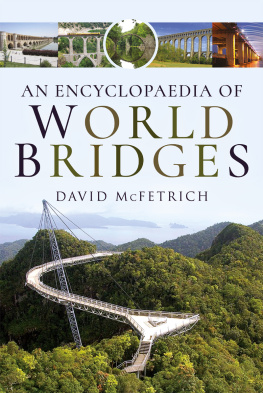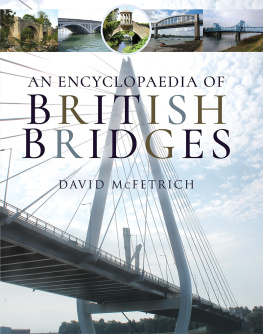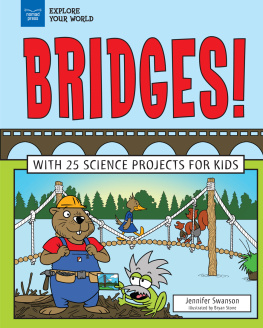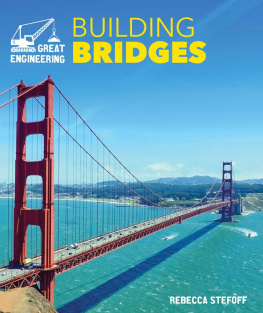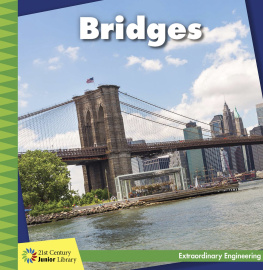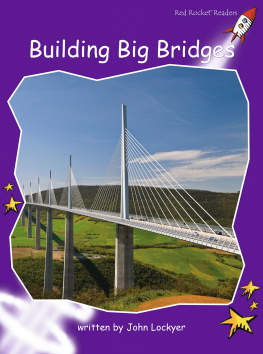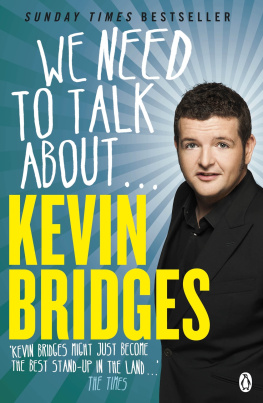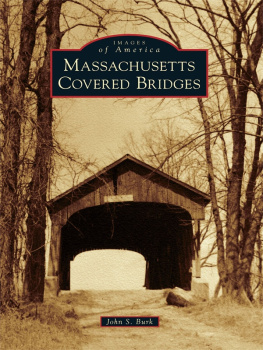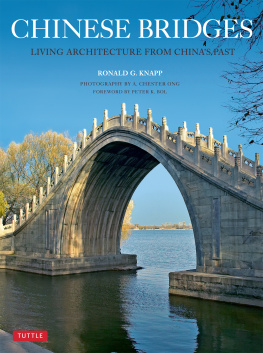Pagebreaks of the print version

AN ENCYCLOPAEDIA OF
WORLD
BRIDGES
AN ENCYCLOPAEDIA OF
WORLD
BRIDGES
D AVID M C FETRICH
First published in Great Britain in 2022 by
Pen and Sword Transport
An imprint of
Pen & Sword Books Ltd.
Yorkshire - Philadelphia
Copyright David McFetrich, 2022
ISBN 978 1 52679 446 8
eISBN 978 1 52679 447 5
The right of David McFetrich to be identified as author of this work has been asserted by him in accordance with the Copyright, Designs and Patents Act 1988.
A CIP catalogue record for this book is available from the British Library.
All rights reserved. No part of this book may be reproduced or transmitted in any form or by any means, electronic or mechanical including photocopying, recording or by any information storage and retrieval system, without permission from the Publisher in writing.
by SJmagic DESIGN SERVICES, India.
Pen & Sword Books Ltd incorporates the imprints of Pen & Sword Books Archaeology, Atlas, Aviation, Battleground, Discovery, Family History, History, Maritime, Military, Naval, Politics, Railways, Select, Transport, True Crime, Fiction, Frontline Books, Leo Cooper, Praetorian Press, Seaforth Publishing, Wharncliffe and White Owl.
For a complete list of Pen & Sword titles please contact
PEN & SWORD BOOKS LIMITED
47 Church Street, Barnsley, South Yorkshire, S70 2AS, England
E-mail:
Website: www.pen-and-sword.co.uk
or
PEN AND SWORD BOOKS
1950 Lawrence Rd, Havertown, PA 19083, USA
E-mail:
Website: www.penandswordbooks.com
Introduction
M y interest in bridges began when I was given a copy of the book The Worlds Great Bridges by Hubert Shirley Smith when I was about 15, a gift that helped me decide to become a civil engineer. During my career after leaving university, I both designed and built bridges and, although I changed career after eleven years, I have maintained that interest ever since.
The aim is for this volume to give brief descriptions of some of the worlds most famous bridges that everyone knows, but also to include a wide selection of less well-known bridges that are interesting because they are historic or unusual in some way or have connections with important events or people in history. I have also added several bridges which, though not particularly interesting as structures, are tourist attractions that help to encourage people to visit developing countries which need this economic help. The bridges described in this book are not necessarily the longest, highest or oldest. Some of them indeed are, but all are included simply because I find them interesting.
There are nearly 1,000 main entries in the book but, occasionally, the details of some bridges that are located near each other and share some common theme are integrated into a single entry, for example the River Neva bridges in St Petersburg and the Ancient Roman Bridges still standing in Rome. Furthermore, brief descriptions of predecessor bridges at some sites where relevant information is available are also included. This means that, in total, more than 1,200 differently-named structures are covered. The heading to each entry generally gives the name of the bridge, its location and country. Where bridges cross between countries the heading gives the name of the nearest large town and the country in which it lies.
To help readers find examples of bridges with particular features or historic connections, I have included a section headed Bridge Lists that gives the names of some of the best examples of bridges in the book that have these characteristics. It should be noted, however, that this section is intended to be more a quick guide rather than a fully comprehensive index which would take up too much space.
In terms of countries covered by the book, there are entries for bridges in 174 of the 195 separate countries of the world that are listed by the United Nations, as shown in the table that follows directly after the Geographic Index. However, there are only three entries for Great Britain with one representative entry from each of England, Wales and Scotland: London Bridge, Menai Straits Bridges and Firth of Forth Bridges. These three entries, which include details of predecessor structures on these sites, are therefore also representative of bridges from four major epochs of British bridge-building: medieval, Industrial Revolution, Victorian and twenty-first century. (Bridges in the Northern Ireland part of the United Kingdom are included in this volume under Northern Ireland.) A total of 1,350 entries for British mainland bridges, covering more than 1,600 different structures altogether, are described separately in the sister volume An Encyclopaedia of British Bridges and, where appropriate, occasional mentions in this book about these British bridges are given in the form (see AEBB ).
It is perhaps worth pointing out that the seemingly arbitrary balance of bridges in favour of France and the USA may simply be because these are the countries best represented by books on foreign bridges that are most easily available in British bookshops. However, the main criterion for selection is simply that the bridges chosen are ones that appealed to the author. So, if you think some of your favourite bridges are unfairly excluded, try to make the most of the unusual, sometimes strange, ones that have taken their place. Many of the source books I have used contain much more information than I have space for in this volume so I have included an extensive bibliography.
Where bridges are reasonably well known, their names are given in anglicised form but others are shown using the usual local form of spelling (including diacritics) but in Roman type. Dimensions relating to each bridge are normally given in the units used in that country or as quoted in the majority of the books in which the bridge is described.
How Bridges Work
There are five different types of force that can affect a bridge and each of its constituent parts. These forces, shown in the accompanying diagram, are:
Compression in which an axial load presses on a structural member
Tension in which an axial load pulls on it

Forces on structures
Torsion in which it is subject to twisting along its longitudinal axis
Shear in which two opposing forces, working like the blades of a pair of scissors, are cutting into the member
Bending in which one side of the member is being compressed and the opposite side stretched.
There are five main types of bridge:
Beam bridge this supports its load by its resistance to bending; in truss bridges the bending is resisted by tension and compression forces in a triangular framework
Cantilever bridge this also supports its load by its resistance to bending
Arch bridge this supports its load by its resistance to compression
Suspension bridge here, the main columns are in compression and the suspension cables and hangers are in tension
Stay bridge the main columns are also in compression and the diagonal stays are in tension.
It should be noted that, except in beam bridges where the top part of the beam can form the traffic-bearing deck, in bridges that are principally arch, cable stay or suspension structures the deck itself will usually be a subsidiary structure of some kind, between support points provided by the main structure. On the Forth Bridge, for example, which is a huge cantilever bridge, this main cantilever framework supports an internal viaduct on which the trains run. Elsewhere, this viaduct would be a major beam type of structure in its own right.

